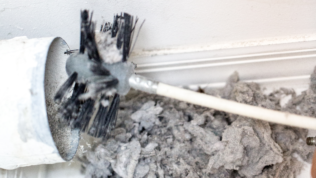You can help prevent a dryer vent fire at your club with a professional, commercial dryer vent cleaning plan. Lint buildup inside dryer ducts is a fire safety hazard, since lint can be extremely flammable and, as a result, is the most common cause of dryer fires.
The dryer vent or, more appropriately, the dryer duct or vent line, runs from the back of the dryer to the outside, exhausting the warm, moist air produced by the drying process. When lint from the drying fabrics collects and starts to block the vent, pressure increases on the dryer’s internal blower. That pressure leads to the steadily rising temperature of the exhaust air, which can ignite combustiblelintin the vent.
Once the lint ignites, fire can spread through the aluminum vent pipe and into the building. The dryer also fans the flames coming from the vent, which can cause the fire to spread through the entire facility.
Establish a quarterly cleaning schedule to ensure that dryers consistently run efficiently and can meet the demand for your club, especially if you launder a high volume of towels. Your club may require frequent dryer vent line cleaning because:
- Dryers often run all day for a few days a week.
- Commercial vent lines tend to be significantly longer than residential lines, and often serve several machines and a large population.
- Fitness facilities frequently dry towels, which produce more lint than other laundry items.
These conditions indicate that lint may be restricting your club’s dryer vent and increasing the risk of a fire:
- Items are taking longer than normal to dry.
- Items seem hotter than usual at the end of a drying cycle.
- The flapper on your exterior dryer vent doesn’t open when the dryer is on.
Although regular cleaning, or at least inspection, of your dryer vents is recommended, it’s important that your staff members are trained to recognize the indications that your vents need to be cleaned. Reputable, commercial dryer vent cleaners are experienced and equipped to handle properties of all sizes and configurations, and yearly contracts establish consistency and predictability with the cleaning process.
This loss control information is advisory only. The author assumes no responsibility for management or control of loss control activities. Not all exposures are identified in this article.

